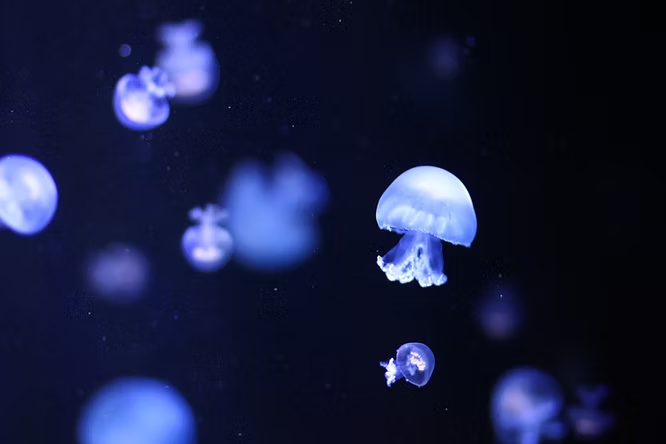Jellyfish Blooms: When the Ocean Tips Out of Balance
All around the globe, people are seeing unprecedented blooms of jellyfish. Once rare in many regions, swarms of tens of thousands now clog fishing nets, disrupt industries, and even overturn boats—as happened in Japan with giant jellyfish reaching six feet across. But why are jellyfish suddenly everywhere, and what does this mean for marine ecosystems?
Why Jellyfish Populations Explode
Several factors contribute to the rise of jellyfish blooms:
- Overfishing: Small fish like sardines and anchovies, which normally compete with jellyfish for food, are heavily fished. With fewer rivals, jellyfish flourish.
- Pollution: Jellyfish tolerate low-oxygen “dead zones” far better than fish, allowing them to thrive where other species cannot.
- Feedback loops: Once abundant, jellyfish consume fish larvae, further reducing fish populations and reinforcing their own dominance.
This ecological flip can be difficult to reverse, and once jellyfish take over an area, the balance of the local ecosystem may be permanently altered.
Are Jellyfish a Dead End?
Despite their reputation as nuisances, jellyfish are not always ecological dead ends. In southwestern Africa, the five-inch bearded goby has found a way to turn jellyfish into a survival strategy. During the day, gobies hide in oxygen-poor, toxic mud on the seafloor. At night, they surface, breathing freely and feeding on jellyfish—making up about 60 percent of their diet. The gobies also shelter among jellyfish tentacles, gaining protection from predators. By eating jellyfish, these small fish provide a vital link in the food chain to seabirds, larger fish, and marine mammals.
Who Eats Jellyfish?
More predators consume jellyfish than one might expect. Over 120 fish species and more than 30 other animals feed on them, at least occasionally. Notable jellyfish eaters include:
- Ocean sunfish: The heaviest bony fish on Earth, it specializes in jellyfish.
- Leatherback turtles: Critically endangered, they rely heavily on jellyfish as a food source.
- Mushroom corals: Recently observed in the Red Sea swallowing jellies half their size.
- Crabs: Opportunistic feeders that have been spotted eating moon jellies during coral spawning events.
Humans as Jellyfish Predators
One proposed solution to jellyfish overabundance is to add more humans to their list of predators. Jellyfish have been part of Chinese cuisine since at least 300 AD, and today more than 425,000 tonnes are harvested each year. They appear in everything from salads in the United States to unusual desserts in Japan. Could jellyfish one day be as common as peanut butter in our diets? Perhaps—if we develop a taste for them.
Looking Ahead
As overfishing and ocean changes fuel the spread of jellyfish, ecosystems face new challenges. Yet nature has shown resilience, with species like gobies, turtles, and corals adapting to use jellyfish as food. Humans may also play a role in restoring balance—by rethinking what belongs on the menu.

